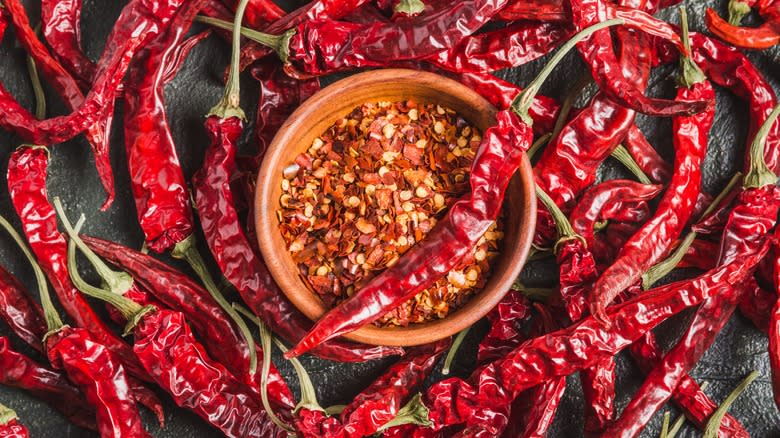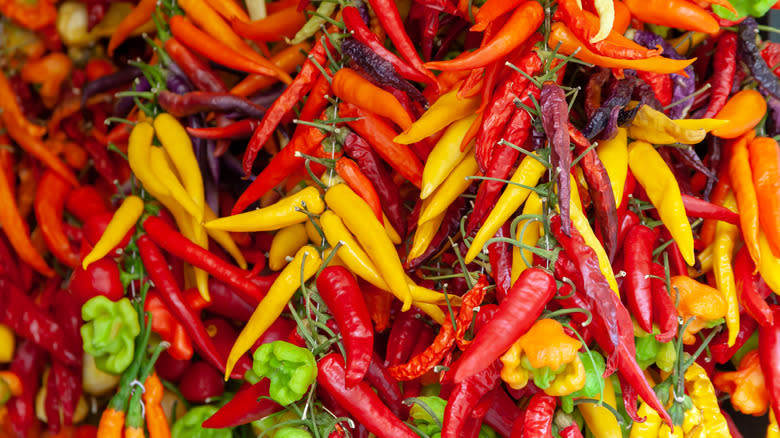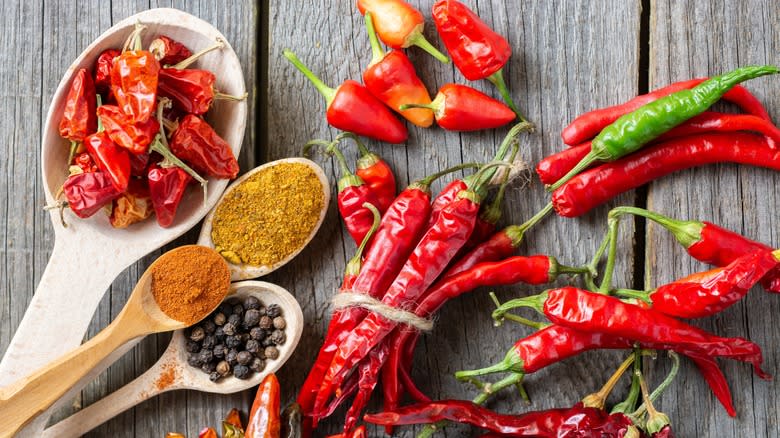The Qualities To Consider When Making Homemade Pepper Flakes

Even with the widespread availability of pepper flakes in grocery stores, you might still want to try your hand at making your own. Like any other homemade product, crafting your own pepper flakes allows you to control the exact flavor and texture of the end result.
Several important factors need to be considered when making homemade pepper flakes. The first is fairly obvious: How spicy do you want your flakes to be? The heat levels of chilies can vary greatly depending on the species, ranging from virtually no heat, as with bell peppers, to extreme spiciness, like the bhut jolokia, which made headlines in 2016 for causing one man enough discomfort to necessitate a trip to the hospital. This spiciness is measured using the Scoville scale, which assesses the concentration of capsaicin — the chemical responsible for the heat — in the pepper.
Beyond spiciness, it's also important to consider the flavor profile of the pepper itself. Botanically classified as fruits, some peppers are sweeter than others and may have a more vegetal taste. For example, habanero peppers are incredibly spicy but also offer a distinctively fragrant and fruity flavor, making them a popular choice in Mexican and Caribbean dishes.
Read more: 5 Rice Brands To Buy, And 5 To Avoid
Pepper Flake Textures

Apart from the type of chile pepper used, the preparation method also affects the final product. While removing the seeds can be a meticulous task, leaving them in may add a mild bitterness to the flakes. The seeds can also be texturally off-putting for some people, especially when using chile varieties that are particularly seedy.
If you're drying the chiles at home, you might consider incorporating smoke into the process. For example, smoked paprika is made by gently drying peppers over oak wood — a technique you can adapt for your own use. Set up a home smoker with the wood and chile pepper varieties you'd like to experiment with to achieve a truly personalized flavor.
The last consideration is the grind size. Place the dried chiles in a specialized spice grinder or a basic coffee grinder and process them until they reach your preferred size. Larger flakes are ideal for sprinkling on top of pizza slices and pastas, whereas a finer grind is better suited for mixing with other powdered ingredients to create spice blends.
Spicy Flavor Combinations

One of the advantages of grinding your own spices at home is the guarantee of freshness, and making your own chile flakes is no exception. Freshly crushed peppers are undeniably more aromatic and flavorful than the mass-produced commercial brands found in grocery stores.
Store-bought pepper flakes often consist of a blend of different chiles, and you can adopt this approach for your own blend. Use milder varieties like California chiles as the base of your mix, and elevate the spice levels by including hotter varieties such as Pequin or Thai chile peppers like bird's eye.
You can also blend the crushed chile flakes or ground chile powder with other spices to create your own spice rubs and masalas. For instance, if you enjoy adding both heat and a savory touch to your dishes, consider mixing the processed chiles with onion and garlic powder. You can even take this concept a step further by crafting your own curry powders, grinding each ingredient according to your specific preferences.
Read the original article on Daily Meal.
